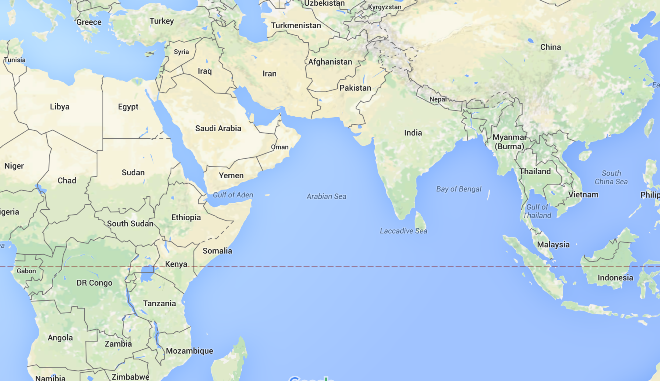
CHINA has made a move. It wants a piece of the action in a tiny country in the Horn of Africa.
It’s a long and complex story. And this is the short of it.
Bab-el-Mandeb is the narrow sea channel that separates Djibouti from Yemen. If you stand on Ras Siyyan – the sharp peninsula that juts out from the eastern coast of Djibouti, Asia is only 30km away.
It is said that many centuries ago, modern day Djibouti and Yemen were one – or only separated by marshy land – so it was quite easy to walk across.
Bab-el-Mandeb means “Gate of Tears” in Arabic, and legend has it that it is named after the cries of those who drowned when a violent earthquake tore Africa from Arabia and water rushed into the rift, creating the channel.
There’s a large grain of truth to it. Bab-el-Mandeb is a very unique point in the earth’s crust, where three fault lines meet. The Arabian plate pulls apart from the African plate, which is then split in two by the Great Rift Valley fault line.
In 1869, the Suez Canal in Egypt was opened, shortening the Asia-Europe shipping route by more than 6,000km.
Camp Lemmonier
The two great colonial powers at the time, France and Britain, recognised the unique strategic importance of Bab-el-Mandeb as it guards the entrance to the Red Sea and ultimately Suez, and so established two naval bases to control access. France took Djibouti on the African side, and Britain took Aden in Yemen.
In the 21st century, the foreign interests expanded to include the US and Japan, along with former colonial power France.
The largest military presence is at the US base in Camp Lemmonier in Djibouti. It provides a vital base for US Special Forces, fighter planes and helicopters, as well as serving as a base for drone operations into Somalia and Yemen, as we at Mail & Guardian Africa recently wrote about.
Now, China is said to be sniffing around too. Last weekend, a top Chinese military officer visited Djibouti, official media reported, prompting a state-run newspaper Tuesday to downplay concerns Beijing is planning to establish a base there.
The chief of the People’s Liberation Army (PLA) general staff, General Fang Fenghui met Djibouti’s president Ismail Omar Guelleh, and official communication stated that China was willing to “deepen pragmatic cooperation between the two countries and two militaries.”
In May, Guelleh told AFP that “discussions are ongoing” with China for a military base in the tiny Horn of Africa nation, saying that Beijing’s presence would be “welcome”.
Djibouti’s population is just 850,000; 60% of which is in the port city of Djibouti. The rest of the country is virtually empty – population density is just 2-10 people per square km – making it logistically easy to establish bases there. You’re not going to be stepping on anyone’s garden. And militaries like that.
Bab-el-Mandeb chokepoint
But the bigger reason for global attention on Djibouti is because Bab-el-Mandeb is one of the world’s major shipping chokepoints.
An estimated 3.2 million barrels of oil pass through the straits every day, 4% of the world’s oil trade, from the Persian Gulf to the Suez Canal, and onwards to the Mediterranean Sea Europe, and beyond, according to data from the US Energy Information Administration.
Just 30km across, and split further in the middle by the island of Perim, navigating the straits is a tricky affair for ships.
Blocking a chokepoint, even temporarily, can lead to rapid and substantial increases in world energy prices, and add thousands of miles of transit in alternative routes.
In August, Egypt launched a new and expanded Suez Canal, with a price tag of $6 billion. It is intended to speed up traffic along the existing waterway, and double revenues for the Suez Canal Authority from $5.3 billion expected at the end of 2015 to $13.2 billion in 2023, officials say. So its security will be an even bigger concern going forward.
Enter Somalia’s pirates
A few years ago, the threat of Somali pirates blocking shipments through Bab-el-Mandeb created perhaps the largest assembly of naval forces for a single military operation, 24 in all. For the first time since World War II, all five permanent members of the Security Council – typically split ideologically down the middle – deployed forces against the same foe.
Today, Somali piracy is all but ended. But the strategic needs to control the straits continues, particularly as Beijing expands its military heft and reach.
China has recorded annual double-digit increases in its defence budget, and is in the early stages of a massive modernisation and organisational overhaul of its military.
China’s first aircraft carrier – the ultimate in warships – recently entered service, and has been stationed in the Western Pacific. At last count, just 20 aircraft carriers are in active service around the world; the US owns half of them.
It’s part of a broader trend of China exerting dominance in the Indian Ocean rim, much in the way that the US hegemony was achieved by controlling the greater Caribbean in the 19th Century.
American power
With the completion of the Panama Canal in 1914, the US was able to circle both the Atlantic and Pacific oceans, and its dominance of the Western hemisphere was complete.
Now, the centre of military power in the world is moving to Asia, a consequence of the region’s economic expansion. As countries consolidate their institutions at home and do more trade and business abroad, they seek to project military might as well in order to defend their new interests.
It’s no different for China.
Bab-el-Mandeb is also making global powers nervous because of the turmoil in Yemen. The Houthi rebels, who overthrew the government in Sana’a last year, are based in the rugged mountains of Yemen overlooking the Red Sea, and have now taken over most of the territory formerly known as North Yemen.
They are Shi’a Muslims, supported by Iran – the global stronghold of Shi’a Islam. But apart from their religious affiliation, there’s a starker, more earthly reason for Iran’s interest in Yemen. The world’s most important shipping chokehold is in the Strait of Hormuz, which separates Iran from Oman.
In 2013, 17 million barrels of oil passed through Hormuz, from the Persian Gulf into the Arabia Sea. It’s equivalent of 18% of the world’s trade in oil, and many times, Iran has harassed oil tankers passing through the Hormuz, triggering military action from the US.
Iran’s game
By supporting the Houthi rebels, Iran could one day control a combined 22% of the world’s oil trade by projecting power both on the Strait of Hormuz and Bab-el-Mandeb.
It is Iran’s strategy to collect enough of these small power projection capabilities in order to eventually become a dominant world power, argues Russ Read, the deputy director of Legislative Affairs at EMET, a Washington-based foreign policy think tank.
But there’s more. On Djibouti’s land side is Ethiopia.
The country has ramped up infrastructure spend in the past few years. There’s been intensive investment in rail infrastructure, with a line from Djibouti to Addis Ababa opened this year, and another project linking Addis Ababa with the cities of Jimma, Bedele and Ambo launched in May.
Another railway from a port in the Djiboutian town of Tadjourah port to Bahir Dar city and from the capital south to the cities of Hawassa and Arba Minch is expected to be completed by July 2020.
More ambitious is the planned transcontinental line that will link Djibouti and Ethiopia all the way across the continent to the Gulf of Guinea in West Africa.
Plans also being made to build a $4 billion second international airport in the Addis Ababa area, one that could serve as many as 120 million passengers per year when it opens in about a decade’s time. That’s passenger traffic larger than Heathrow’s in London.
That puts Djibouti at the confluence of three major geopolitical interests – a rising Ethiopia (which will uplift the whole Horn of Africa), shifting power plays in the Indian Ocean rim, featuring China and Iran, and the traditional hegemonic powers – led by the US – that see their unquestioned dominance threatened.
It’s like the days of old, when Bab-el-Mandeb itself was created by tectonic movements along three fault lines.
What remains to be seen is whether this time round, there will be cries of lamentation as in the legend, or something altogether different.































